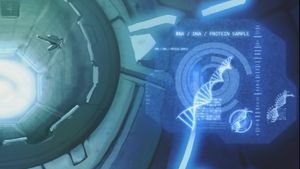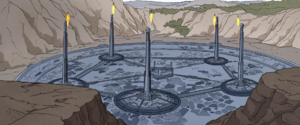Conservation Measure
From Halopedia, the Halo wiki
- "The Conservation Measure is the only sweet note in this discordant symphony we've arranged. It's the only constructive activity in decades of destruction."
- — Unknown Forerunner individual, likely the Librarian[1]
The Conservation Measure,[1][2][3] also known as the Library Project,[4] was a massive undertaking by the Forerunners to index and preserve biological diversity in the Milky Way Galaxy before and during the Forerunner-Flood war.
History
When the possibility of the Halo Array was first proposed, the Librarian responded with outrage at the Builders' idea of defeating the Flood by committing galactic genocide, and petitioned Master Builder Faber and the Council to take measures to preserve the galaxy's life-forms in the event of the Halo Array's firing. As the Lifeworkers could halt medical science if they abandoned their duties in protest, Faber concluded that it would be less expensive to give in to the Librarian than fight her, so he agreed to her request.[5] As a result, the installations involved in the Halo Array, including the Halos themselves as well as the Arks which produced the rings - first the greater Ark and later Installation 00 - were constructed to have surface conditions suitable for varying types of life, enabling the Lifeworkers to use them as biological preserves. A variety of other facilities aboard the installations, including the Libraries, were used to catalog and study the specimens.[3] There were quite a few problems at first, mainly with regards to categorizing the races into specific categories.[4]
Toward the end of the Flood conflict, the Master Builder began to alter his pact with the Librarian and authorized the use of the Lifeworkers' biological specimens on the Halos for experimentation on the Flood, hoping to learn more about the parasite.[6] Humans, in particular, were subjected to rigorous tests on Installation 07, due to the supposed immunity they appeared to exhibit to Flood infection.[7]
As it became increasingly obvious that the Array would be the only means to defeat the Gravemind, the Librarian urged her husband, the IsoDidact, to fire the Array. But the Didact, still clinging to the Mantle and unwilling to kill his wife with the Array, delayed the activation. In an effort to force the Didact's hand, and knowing that the Flood would soon find the Ark with Mendicant Bias' help, the Librarian destroyed her keyships on Earth, stranding her in the Array's radius of fire. Without any option left, the Didact fired the Array.[8]
After the Flood was defeated, the surviving Lifeworkers on the Ark began the process of repopulating the galaxy in a stage referred to as the reintroduction, sending all the races back to their respective homeworlds. While a success, the Conservation Measure also sent each race back to a Tier 7 scale, forcing the sentient races to start over.[4] The period directly after the reintroduction was referred to as "the dark time", as some of the indexed species never recovered and subsequently became extinct.[9]
Two reintroduced races - the San 'Shyuum and Sangheili - would end up worshiping the Forerunners as gods, something the Forerunners hardly anticipated. The data concerning the Conservation Measure was preserved at the Ark, a revelation which surprised 343 Guilty Spark.[8]
Trivia
A total of 123 sapient, technologically capable species had been indexed by the project at time of the evacuation of Earth.[10]
Gallery
List of appearances
- Halo: The Flood (First appearance)
- Halo 3
- Halo: Legends
- Halo: Cryptum
- Halo: Combat Evolved Anniversary (Mentioned only)
- Halo: Primordium
- Halo 4
- Halo: Silentium
Sources
- ^ a b Iris, Episode 4
- ^ Halo: The Essential Visual Guide, page 14
- ^ a b Halo: Combat Evolved Anniversary - Library: Activation Index
- ^ a b c Halo: The Flood: Adjunct
- ^ Halo: Cryptum, page 274
- ^ Halo: Cryptum, page 334
- ^ Halo: Primordium, page 365
- ^ a b Halo 3 Terminals
- ^ Halo Waypoint - Bestiarum
- ^ Halo: Silentium, page 18



